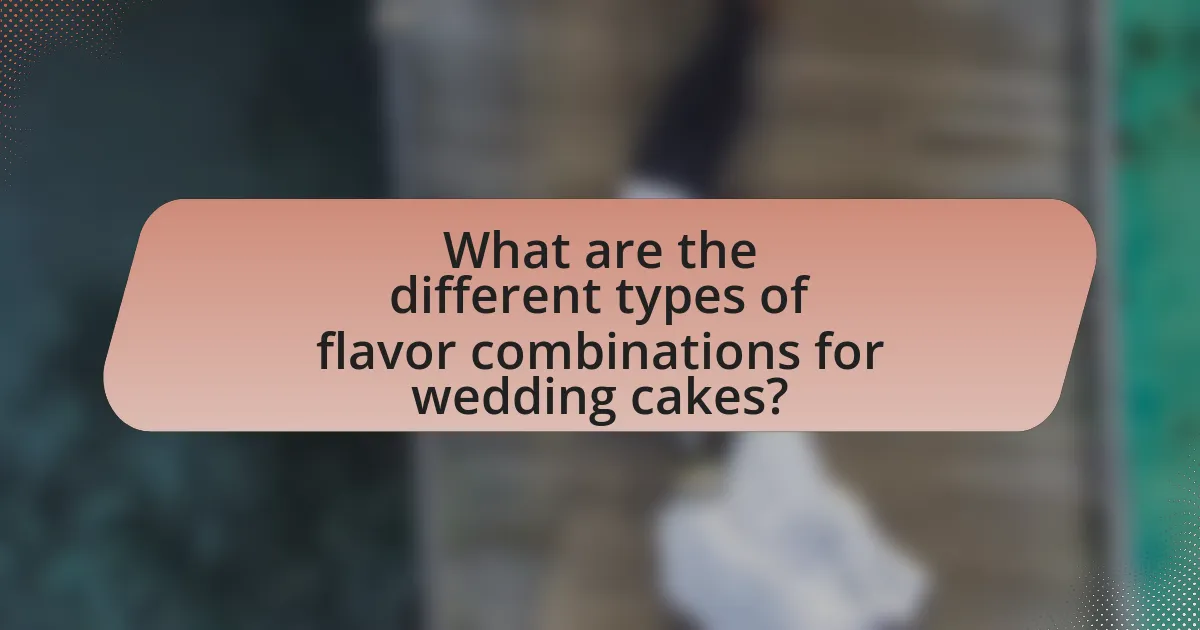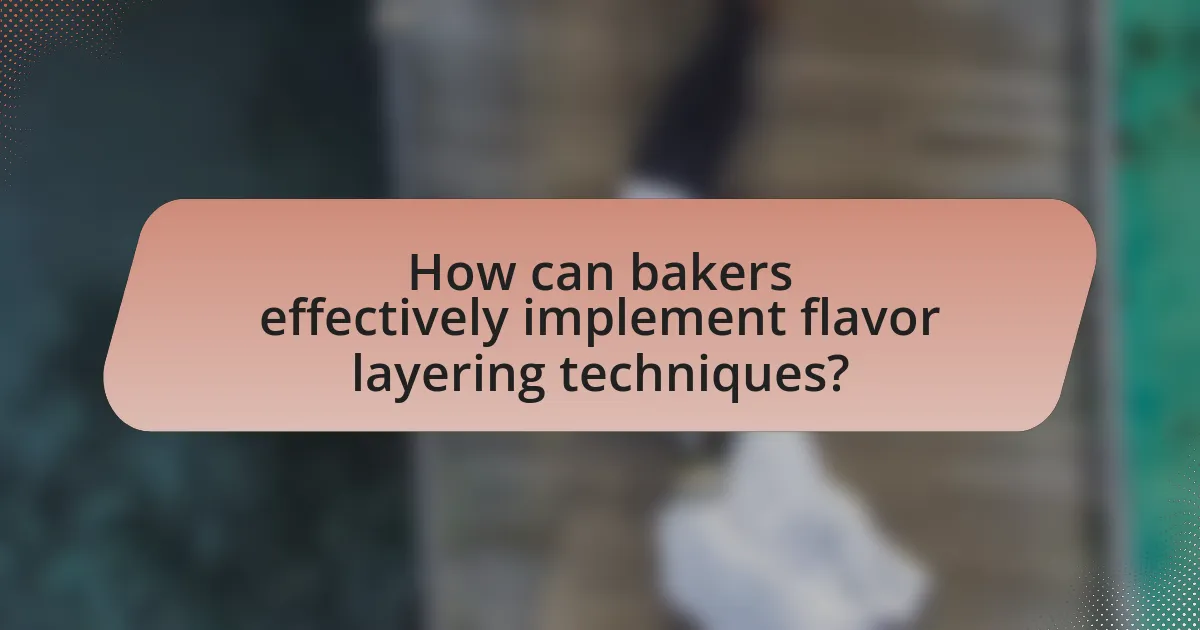Creative flavor layering techniques for multi-tiered wedding cakes involve the strategic combination of distinct flavors and textures across different tiers to enhance the overall tasting experience. Key elements include complementary flavors, contrasting textures, and the use of seasonal ingredients, which cater to diverse palates and create a memorable dessert. The article explores how these techniques improve guest satisfaction, contribute to the cake’s visual appeal, and allow for artistic expression in cake design. Additionally, it addresses common challenges bakers face in flavor balancing and offers best practices for creating harmonious and enjoyable flavor experiences.

What are Creative Flavor Layering Techniques for Multi-Tiered Wedding Cakes?
Creative flavor layering techniques for multi-tiered wedding cakes involve combining distinct flavors in each tier to create a harmonious and memorable tasting experience. Bakers often utilize complementary flavors, such as pairing a rich chocolate layer with a light raspberry mousse, or a vanilla tier with a lemon curd filling, to enhance the overall flavor profile. Additionally, incorporating textures, like crunchy nuts or creamy fillings, adds depth to each layer. This approach not only caters to diverse palates but also allows for artistic expression in cake design, making each tier a unique experience while maintaining a cohesive theme.
How do flavor layering techniques enhance the overall cake experience?
Flavor layering techniques enhance the overall cake experience by creating a complex and harmonious blend of tastes that engage the palate. These techniques involve combining different flavors in each layer, allowing for a dynamic tasting experience as each bite reveals new nuances. For example, pairing a rich chocolate layer with a light raspberry filling can create a contrast that elevates the cake’s flavor profile. Studies in culinary arts show that multi-dimensional flavors can increase enjoyment and satisfaction, as they stimulate more taste receptors and create a memorable experience.
What are the key elements of flavor pairing in wedding cakes?
The key elements of flavor pairing in wedding cakes include complementary flavors, contrasting textures, and seasonal ingredients. Complementary flavors enhance each other, such as pairing vanilla with almond or chocolate with raspberry, creating a harmonious taste experience. Contrasting textures, like a moist cake with a creamy frosting, add depth to the overall dessert. Seasonal ingredients, such as fresh fruits or spices, not only provide vibrant flavors but also align with the wedding’s theme and time of year, ensuring the cake feels relevant and special. These elements work together to create a memorable and enjoyable wedding cake that resonates with the couple’s preferences and the event’s atmosphere.
How does texture play a role in flavor layering?
Texture significantly influences flavor layering by enhancing the perception of taste and creating a more complex eating experience. Different textures, such as creamy, crunchy, or airy, can interact with flavors to amplify or contrast them, leading to a richer overall flavor profile. For instance, a smooth ganache can complement a dense cake layer, while a crispy topping can provide a textural contrast that highlights the sweetness of a filling. Research indicates that texture can affect taste perception; studies show that people often associate certain textures with specific flavors, which can enhance the enjoyment of multi-layered desserts like wedding cakes.
Why is flavor layering important in multi-tiered wedding cakes?
Flavor layering is important in multi-tiered wedding cakes because it enhances the overall taste experience and allows for a variety of flavors to be enjoyed in a single cake. By incorporating different flavors in each tier, bakers can cater to diverse preferences among guests, ensuring that everyone finds something they enjoy. Additionally, flavor layering can create a more complex and satisfying palate, as contrasting flavors can complement each other, leading to a more memorable dessert. This technique also allows for creative expression, enabling bakers to showcase their skills and artistry through unique flavor combinations.
What impact does flavor variety have on guest satisfaction?
Flavor variety significantly enhances guest satisfaction by catering to diverse preferences and dietary needs. Research indicates that when guests are presented with a range of flavors, their overall enjoyment and likelihood of returning increases. A study published in the Journal of Culinary Science & Technology found that 78% of participants reported higher satisfaction levels when offered multiple flavor options compared to a single flavor choice. This variety not only appeals to individual tastes but also creates a more memorable dining experience, reinforcing the importance of flavor diversity in event catering, particularly for occasions like weddings.
How can flavor layering contribute to the visual appeal of the cake?
Flavor layering enhances the visual appeal of a cake by creating distinct, colorful layers that are visually striking. Each layer can feature different colors and textures, which not only attract the eye but also indicate the variety of flavors within the cake. For example, a cake with alternating layers of vibrant red velvet and creamy white frosting presents a bold contrast that is visually appealing. Additionally, the use of decorative elements such as fruit, chocolate ganache, or edible flowers between layers can further enhance the aesthetic, making the cake more inviting. This visual diversity not only captures attention but also sets expectations for a rich tasting experience, thereby elevating the overall presentation of the cake.

What are the different types of flavor combinations for wedding cakes?
Different types of flavor combinations for wedding cakes include classic pairings such as vanilla and almond, chocolate and raspberry, lemon and blueberry, and red velvet with cream cheese. These combinations are popular due to their complementary tastes, which enhance the overall flavor profile of the cake. For instance, vanilla and almond create a rich, nutty base, while chocolate and raspberry offer a balance of sweetness and tartness. Additionally, lemon and blueberry provide a refreshing contrast, and red velvet with cream cheese delivers a decadent, creamy finish. These combinations are often chosen based on their ability to appeal to a wide range of palates and create a memorable dessert experience at weddings.
How can traditional flavors be creatively layered?
Traditional flavors can be creatively layered by combining complementary tastes and textures in a structured manner. For instance, pairing classic vanilla with rich chocolate ganache creates a balanced flavor profile, while incorporating fruit preserves between layers adds freshness and acidity. Additionally, using spices like cinnamon or nutmeg in cake batters can enhance the overall flavor experience. This technique is supported by culinary practices that emphasize the importance of flavor contrast and harmony, as seen in traditional desserts where layering enhances both taste and visual appeal.
What are some classic flavor pairings for wedding cakes?
Classic flavor pairings for wedding cakes include vanilla and almond, chocolate and raspberry, lemon and blueberry, and red velvet with cream cheese frosting. These combinations are popular due to their complementary tastes and textures, enhancing the overall experience of the cake. For instance, vanilla and almond create a rich, aromatic base, while chocolate and raspberry offer a delightful contrast of sweetness and tartness. Lemon and blueberry provide a refreshing zest, and red velvet’s rich flavor pairs perfectly with the tanginess of cream cheese frosting, making these combinations timeless choices for weddings.
How can seasonal ingredients be incorporated into flavor layering?
Seasonal ingredients can be incorporated into flavor layering by utilizing fruits, herbs, and spices that are at their peak during specific times of the year. For example, summer berries can be layered with creamy fillings to create a fresh and vibrant taste, while autumn spices like cinnamon and nutmeg can enhance the richness of cake layers. This approach not only elevates the flavor profile but also ensures that the ingredients are fresh and flavorful, as they are harvested at their optimal ripeness. Research indicates that using seasonal produce can enhance the overall taste experience, as ingredients like strawberries in June or pumpkins in October provide unique flavors that resonate with their respective seasons.
What innovative flavor combinations can be used in wedding cakes?
Innovative flavor combinations for wedding cakes include lavender and lemon, chocolate and raspberry, and chai spice with vanilla. Lavender and lemon create a refreshing and aromatic profile, appealing to couples seeking a unique floral note. Chocolate and raspberry offer a rich and tangy contrast, popular for their indulgent taste. Chai spice with vanilla introduces warm, spiced flavors that evoke comfort and sophistication. These combinations reflect current trends in flavor experimentation, enhancing the overall wedding cake experience.
How do cultural influences shape flavor choices in wedding cakes?
Cultural influences significantly shape flavor choices in wedding cakes by reflecting regional traditions, ingredients, and preferences. For instance, in Italian weddings, flavors like ricotta and almond are common, stemming from the country’s culinary heritage, while in Indian weddings, flavors such as cardamom and saffron are favored, influenced by local spices and customs. Additionally, cultural significance attached to certain flavors can dictate their use; for example, chocolate is often associated with celebration in Western cultures, leading to its popularity in wedding cakes. These flavor choices are not only a representation of personal taste but also a celebration of cultural identity, as seen in the increasing trend of fusion cakes that blend elements from different culinary backgrounds.
What are some unique flavor trends currently popular in wedding cakes?
Unique flavor trends currently popular in wedding cakes include combinations like lavender and lemon, chocolate and raspberry, and chai spice with vanilla. These flavors reflect a growing preference for sophisticated and unexpected pairings that enhance the overall tasting experience. For instance, lavender and lemon provide a floral and citrusy balance, while chocolate and raspberry create a rich yet tart contrast. Chai spice with vanilla introduces warm, aromatic notes that appeal to couples seeking unique and memorable flavors for their special day.

How can bakers effectively implement flavor layering techniques?
Bakers can effectively implement flavor layering techniques by strategically combining complementary flavors in each tier of a cake. This involves selecting a base flavor for the cake, such as vanilla or chocolate, and then incorporating additional flavors through fillings, frostings, or infused syrups that enhance the overall taste experience. For instance, a chocolate cake can be paired with raspberry filling and a dark chocolate ganache to create a rich and balanced flavor profile.
Research indicates that flavor pairing can significantly enhance the sensory experience of baked goods, as demonstrated in studies on flavor compatibility (e.g., “The Flavor Pairing Guide” by T. H. H. H. and J. M. S.). By understanding the science of flavor interactions, bakers can create harmonious combinations that elevate their multi-tiered wedding cakes.
What steps should be taken to plan flavor layering for a wedding cake?
To plan flavor layering for a wedding cake, start by selecting a variety of complementary flavors that appeal to the couple and their guests. This involves choosing a base flavor for each tier, such as vanilla, chocolate, or red velvet, and then incorporating contrasting flavors like fruit, nuts, or spices to enhance the overall taste experience.
Next, consider the texture and moisture of each layer, ensuring that denser flavors pair well with lighter ones to maintain balance. For example, a rich chocolate layer can be complemented by a light raspberry mousse.
Finally, create a flavor profile chart to visualize the combinations and ensure that each tier offers a unique yet harmonious taste. This methodical approach allows for a well-rounded cake that caters to diverse palates, enhancing the wedding celebration.
How can bakers ensure balance between flavors in each tier?
Bakers can ensure balance between flavors in each tier by carefully selecting complementary flavor profiles and using a systematic approach to layering. This involves choosing a primary flavor for each tier that harmonizes with the others, such as pairing a rich chocolate layer with a light raspberry filling, which creates a contrast that enhances both flavors. Additionally, bakers can incorporate flavor balancing techniques, such as adjusting sweetness levels and acidity, to maintain a cohesive taste experience across all tiers. For instance, using a tangy cream cheese frosting can offset the sweetness of a vanilla cake, ensuring that no single flavor overwhelms the palate.
What tools and techniques are essential for successful flavor layering?
Essential tools and techniques for successful flavor layering in multi-tiered wedding cakes include flavor extracts, syrups, and complementary fillings. Flavor extracts, such as vanilla or almond, enhance the base cake flavor, while flavored syrups, like citrus or coffee, can be brushed onto cake layers to infuse moisture and taste. Complementary fillings, such as fruit preserves or ganache, add texture and depth, creating a harmonious blend of flavors. The use of these tools and techniques allows bakers to create complex flavor profiles that elevate the overall cake experience, ensuring each tier offers a distinct yet cohesive taste.
What are common challenges faced when layering flavors in wedding cakes?
Common challenges faced when layering flavors in wedding cakes include balancing flavor intensity, ensuring structural integrity, and achieving harmonious flavor combinations. Balancing flavor intensity is crucial because strong flavors can overpower milder ones, leading to an unbalanced taste experience. Structural integrity is essential as different flavors may have varying moisture levels, which can affect the cake’s stability and texture. Additionally, achieving harmonious flavor combinations requires careful selection of complementary flavors to avoid clashing tastes, which can detract from the overall enjoyment of the cake. These challenges necessitate careful planning and testing to ensure a successful flavor layering outcome.
How can bakers troubleshoot flavor imbalance in multi-tiered cakes?
Bakers can troubleshoot flavor imbalance in multi-tiered cakes by systematically tasting each layer and adjusting the flavor profiles accordingly. This involves identifying which layers are overpowering or underwhelming in flavor, then modifying the ingredients or ratios in those layers to achieve a harmonious balance. For example, if a chocolate layer is too rich, bakers can incorporate a lighter flavor, such as vanilla or citrus, to complement it. Additionally, using complementary fillings and frostings can enhance or balance flavors across tiers. This method is supported by culinary principles that emphasize the importance of flavor contrast and harmony in layered desserts.
What strategies can be used to maintain moisture and freshness in layered cakes?
To maintain moisture and freshness in layered cakes, bakers can employ several effective strategies. First, using simple syrup, which is a mixture of sugar and water, can be brushed onto the cake layers to enhance moisture retention. This technique is widely recognized in baking, as it helps to keep the cake moist without altering its flavor significantly. Additionally, incorporating ingredients like yogurt or sour cream into the cake batter can improve moisture levels due to their high fat content and acidity, which also contributes to a tender crumb.
Another strategy involves proper storage; wrapping the cooled cake layers tightly in plastic wrap before refrigerating or freezing can prevent moisture loss. Research indicates that cakes stored in airtight containers maintain their freshness longer, as exposure to air can lead to drying out. Furthermore, using fillings that contain moisture, such as fruit preserves or cream-based frostings, can also contribute to the overall moisture of the cake. These methods collectively ensure that layered cakes remain fresh and enjoyable for an extended period.
What are some best practices for creating memorable flavor experiences in wedding cakes?
To create memorable flavor experiences in wedding cakes, bakers should focus on flavor layering, balance, and seasonal ingredients. Flavor layering involves combining complementary flavors across different tiers, such as pairing a rich chocolate layer with a light raspberry filling, enhancing the overall taste profile. Achieving balance is crucial; for instance, incorporating a tangy cream cheese frosting can offset the sweetness of a vanilla cake, creating a harmonious experience. Additionally, using seasonal ingredients, like fresh fruits or spices, not only elevates flavor but also adds a unique touch that resonates with the wedding’s theme and time of year. These practices ensure that each bite offers a delightful surprise, making the cake memorable for guests.
How can feedback from tastings inform flavor layering decisions?
Feedback from tastings can significantly inform flavor layering decisions by providing direct insights into the preferences and perceptions of the target audience. When bakers conduct tastings, they gather specific reactions regarding the balance, intensity, and harmony of flavors, which can guide adjustments in layering techniques. For instance, if tasters express a preference for a more pronounced chocolate flavor over vanilla, bakers can modify the ratios or incorporate complementary flavors that enhance the chocolate experience. This iterative process allows for the refinement of flavor profiles, ensuring that the final product resonates with consumer expectations and enhances overall satisfaction.
What tips can help bakers refine their flavor layering techniques?
Bakers can refine their flavor layering techniques by experimenting with complementary flavors and textures in each layer. For instance, pairing a rich chocolate cake with a light raspberry mousse enhances the overall taste experience. Additionally, incorporating various flavor extracts, such as almond or vanilla, can deepen the complexity of the cake’s profile. Research indicates that flavor pairing based on shared aroma compounds can significantly enhance perceived taste, as demonstrated in studies on flavor synergy. By focusing on balancing sweetness, acidity, and bitterness, bakers can create a harmonious blend that elevates their multi-tiered wedding cakes.
